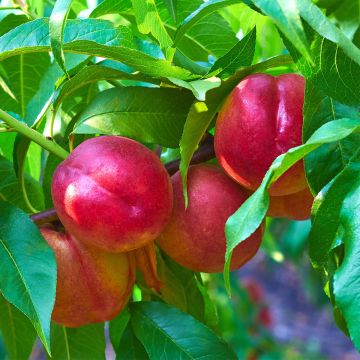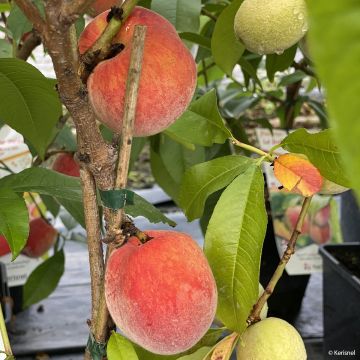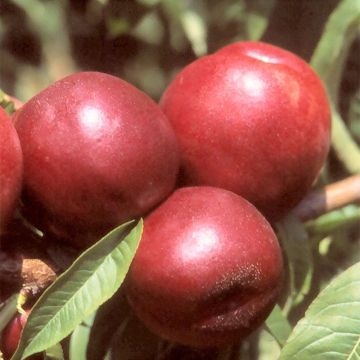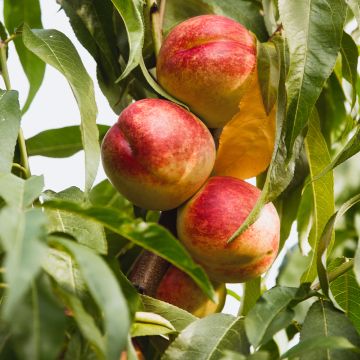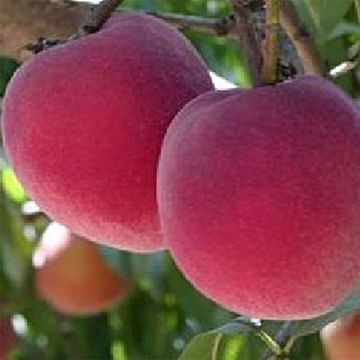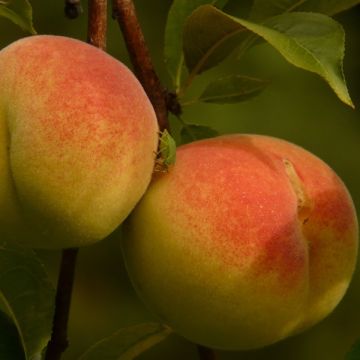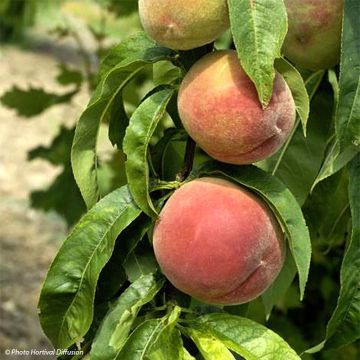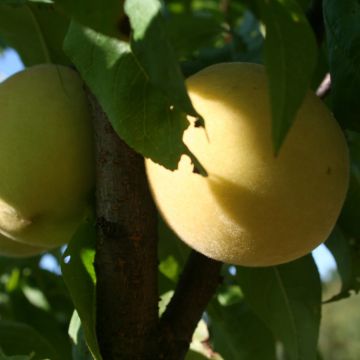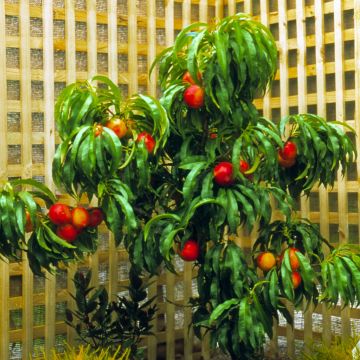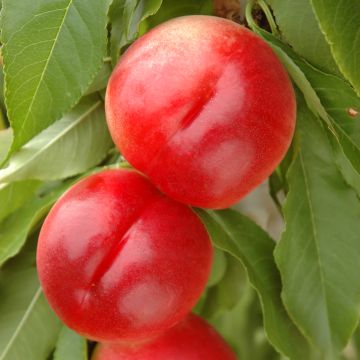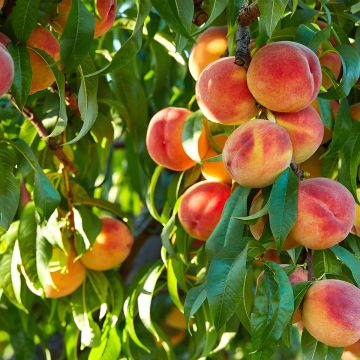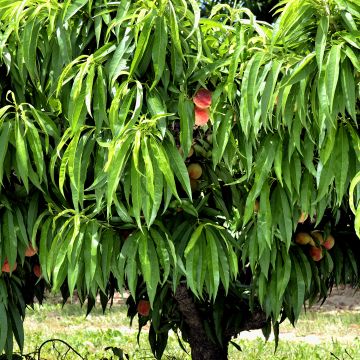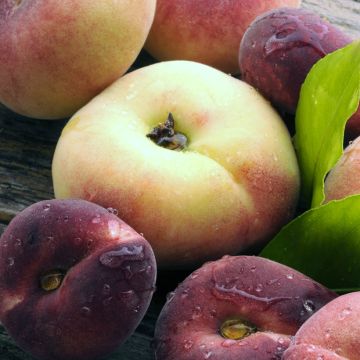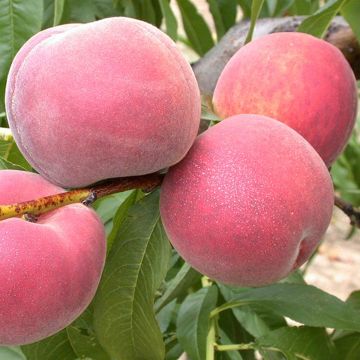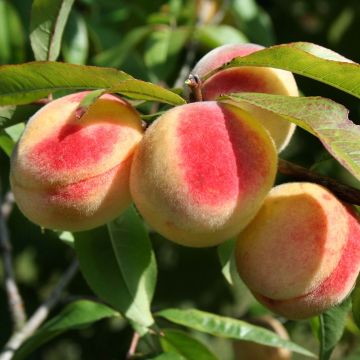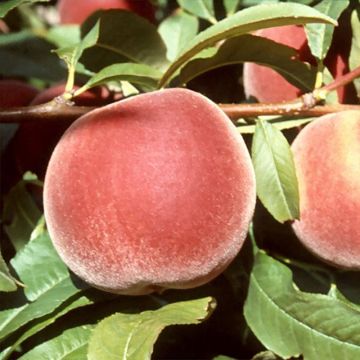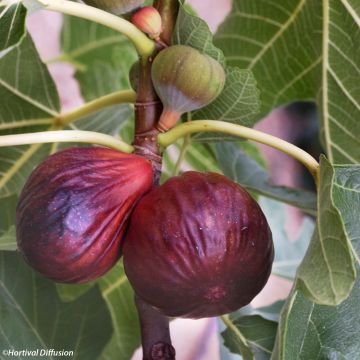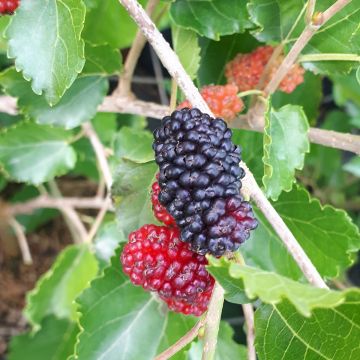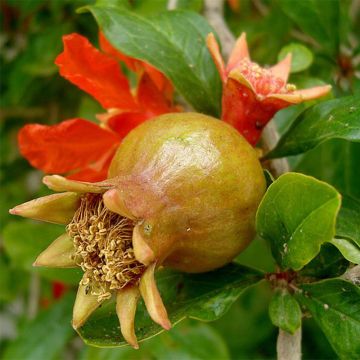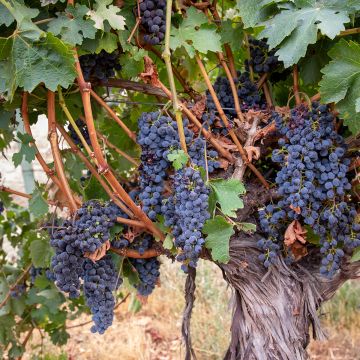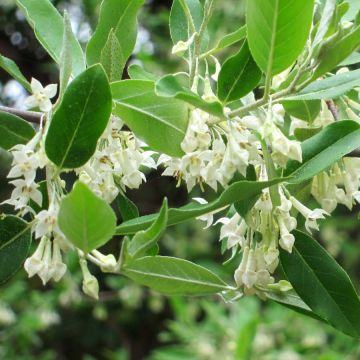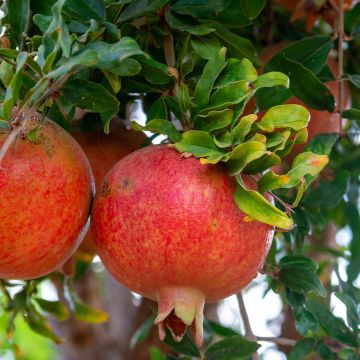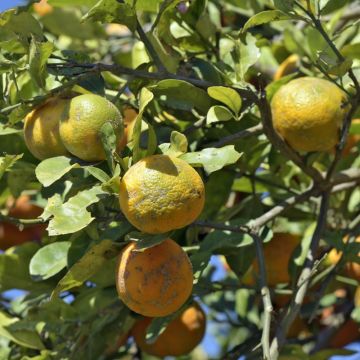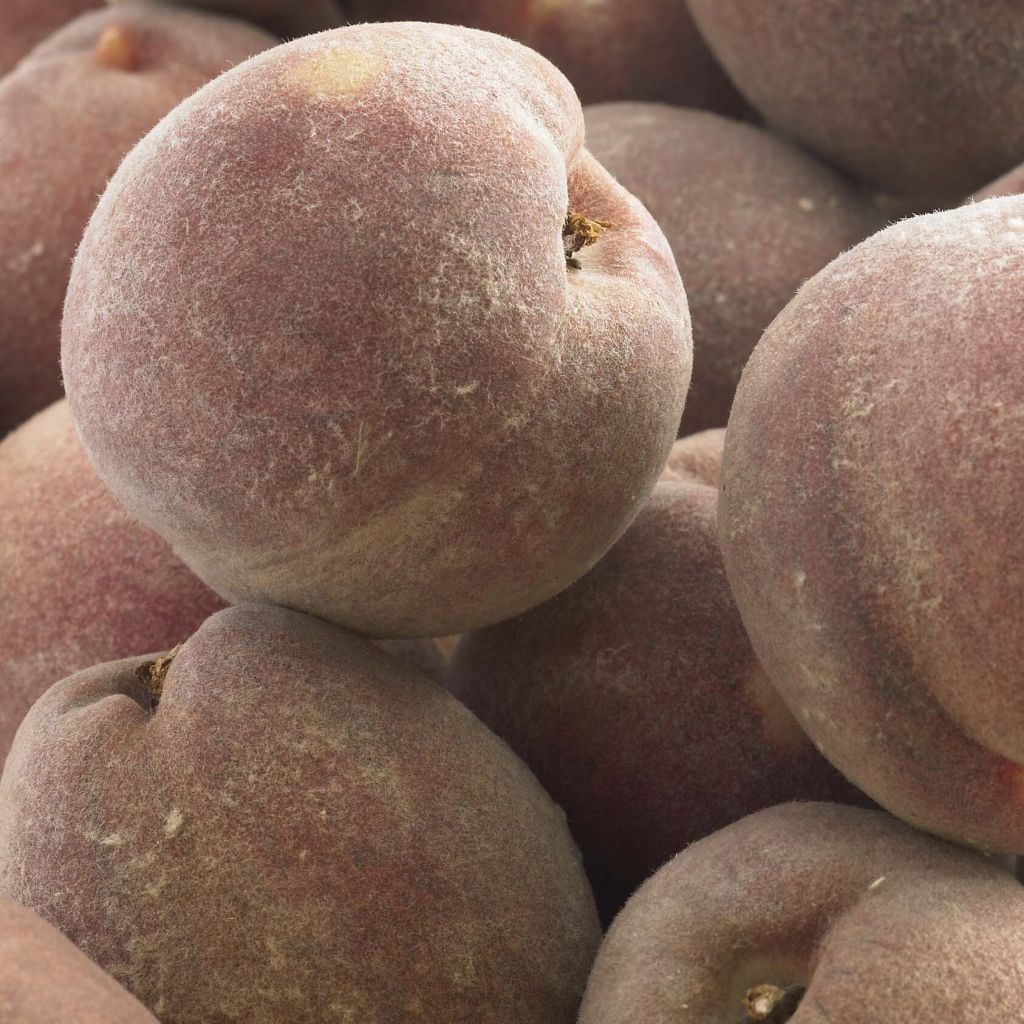

Pêcher de Vigne Sanguine - Pêche de Vigne
Prunus persica Blood Peach - Vineyard Peach
Prunus persica Vigne Sanguine
Peach, Peach tree
Planter en même que notre pommier, belle forme et belle motte bien emballée....
Sylvie, 08/12/2022
Why not try an alternative variety in stock?
View all →This plant carries a 6 months recovery warranty
More information
We guarantee the quality of our plants for a full growing cycle, and will replace at our expense any plant that fails to recover under normal climatic and planting conditions.
From €5.90 for pickup delivery and €6.90 for home delivery
Express home delivery from €8.90.
Delivery to Corse prohibited: UE law prohibits the import of this plant from mainland France to Corse as part of the fight against Xylella fastidiosa. Please accept our sincere apologies.
More information
Description
The Blood Peach is a self-fertile variety, but the presence of another peach tree will improve fertility. Its small round peaches are red with a grey fuzz. Their flesh is white, with a deep red centre, juicy, fragrant, and tangy. They are ideal for making jams, compotes, preserves, and even for eating fresh. The harvest takes place in September when the fruits are ripe.
The species name "persica" was given to the peach tree, which was thought to originate from Persia. In reality, all cultivated forms are native to northern China. Its introduction to Europe took place in the 6th century and experienced significant development in the 19th century. From then on, numerous selections aimed at improving the fruit's taste qualities were made. Vine Peaches were commonly used in vineyards to detect powdery mildew attacks and treat them before they reached the grapevines.
Like many fruit trees, the Blood Peach appreciates light, rich, and deep soils. It does not tolerate excessive moisture or heavy and compact soils well. A sunny location sheltered from the wind will protect the flowering and aid in fruiting. It is a tree with an upright habit, indicating a tall trunk with many vertically growing branches, giving it an elegant and slender silhouette. Its deciduous foliage is a vibrant green and emits a slight almond scent. The leaves are long, measuring 8 to 15cm (3 to 6in) in length and 3 to 4 cm (1 to 2in) in width, with short petioles. Its pale pink flowering occurs late, in April, making it suitable for cultivation in more northern regions. The flowers are hermaphroditic and self-fertile. The fruiting results in small round peaches with red skin and grey fuzz. Their flesh is white, with a unique, sweet, and very melting flavour. This tree does not require too much maintenance and withstands pruning well.
Peaches can be enjoyed raw, cooked, sweetened, salted, flambéed, frozen, or thawed. They pair very well with wine and certain meats, such as duck. They can be found in numerous recipes, including jams, compotes, and pastries.
This fruit tree is delivered in a "ready-to-plant" root ball. When planting, the root ball should be planted as is. The biodegradable material surrounding the root ball, which preserves the rootlets, will decompose naturally during the plant's growth. This method ensures better establishment.
Report an error about the product description
Prunus persica Blood Peach - Vineyard Peach in pictures
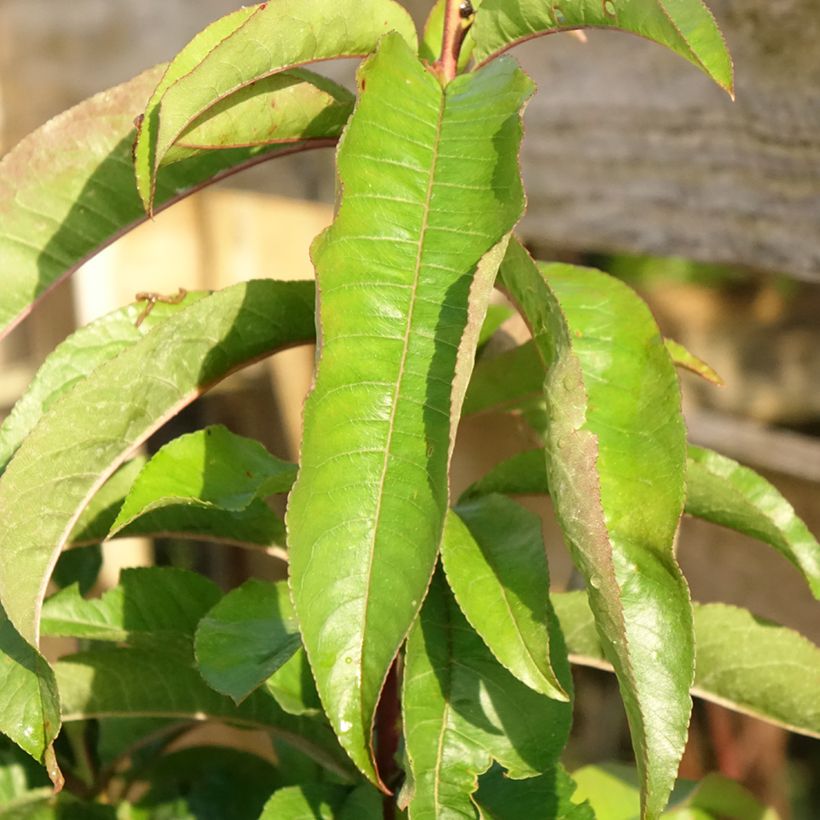

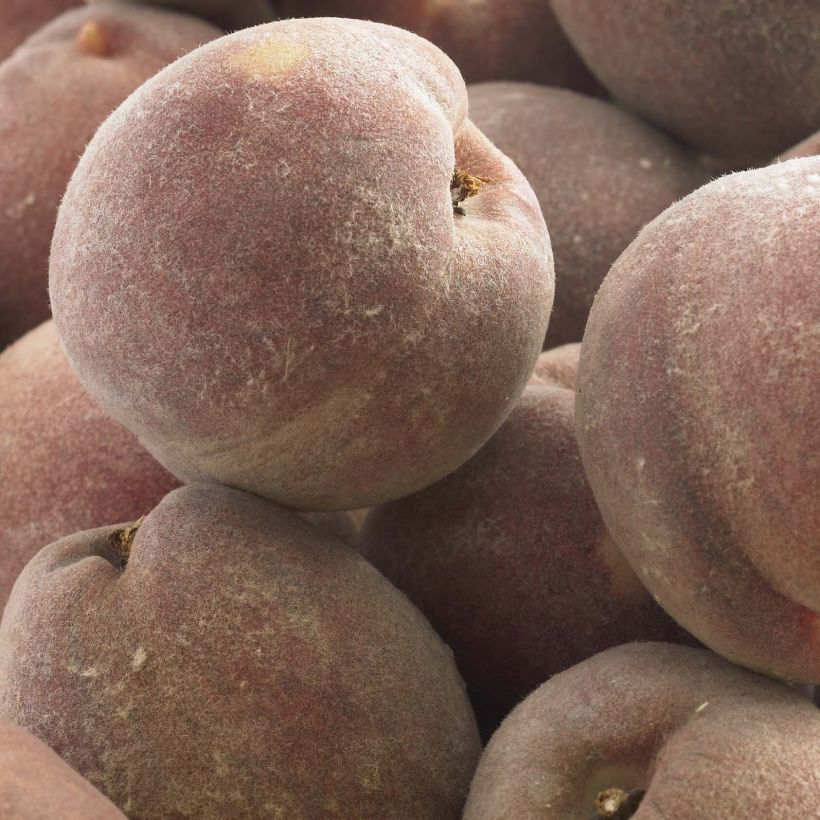

Plant habit
Fruit
Flowering
Foliage
Botanical data
Prunus
persica
Vigne Sanguine
Rosaceae
Peach, Peach tree
Cultivar or hybrid
Other Peach and Nectarine trees
Planting and care
The Blood Peach is preferably planted from October to December. Dig a hole two to three weeks before planting, twice as wide and deep as the pot. On the day, place the tree with its pot in a basin of water, in order to moisten the entire root ball by capillarity. Add compost to the bottom of the hole. Place the tree in the hole, fill with soil mixed with potting soil. Gently tamp around the base of the fruit tree as you fill, the roots should be in close contact with the soil. The root ball should be completely covered. Water generously.
The Blood Peach has a semi-pivoting root system. It will thrive in fairly deep soils. It also prefers a light and well-draining soil.
Planting period
Intended location
Care
-
, onOrder confirmed
Reply from on Promesse de fleurs
Mediterranean fruit trees
Haven't found what you were looking for?
Hardiness is the lowest winter temperature a plant can endure without suffering serious damage or even dying. However, hardiness is affected by location (a sheltered area, such as a patio), protection (winter cover) and soil type (hardiness is improved by well-drained soil).

Photo Sharing Terms & Conditions
In order to encourage gardeners to interact and share their experiences, Promesse de fleurs offers various media enabling content to be uploaded onto its Site - in particular via the ‘Photo sharing’ module.
The User agrees to refrain from:
- Posting any content that is illegal, prejudicial, insulting, racist, inciteful to hatred, revisionist, contrary to public decency, that infringes on privacy or on the privacy rights of third parties, in particular the publicity rights of persons and goods, intellectual property rights, or the right to privacy.
- Submitting content on behalf of a third party;
- Impersonate the identity of a third party and/or publish any personal information about a third party;
In general, the User undertakes to refrain from any unethical behaviour.
All Content (in particular text, comments, files, images, photos, videos, creative works, etc.), which may be subject to property or intellectual property rights, image or other private rights, shall remain the property of the User, subject to the limited rights granted by the terms of the licence granted by Promesse de fleurs as stated below. Users are at liberty to publish or not to publish such Content on the Site, notably via the ‘Photo Sharing’ facility, and accept that this Content shall be made public and freely accessible, notably on the Internet.
Users further acknowledge, undertake to have ,and guarantee that they hold all necessary rights and permissions to publish such material on the Site, in particular with regard to the legislation in force pertaining to any privacy, property, intellectual property, image, or contractual rights, or rights of any other nature. By publishing such Content on the Site, Users acknowledge accepting full liability as publishers of the Content within the meaning of the law, and grant Promesse de fleurs, free of charge, an inclusive, worldwide licence for the said Content for the entire duration of its publication, including all reproduction, representation, up/downloading, displaying, performing, transmission, and storage rights.
Users also grant permission for their name to be linked to the Content and accept that this link may not always be made available.
By engaging in posting material, Users consent to their Content becoming automatically accessible on the Internet, in particular on other sites and/or blogs and/or web pages of the Promesse de fleurs site, including in particular social pages and the Promesse de fleurs catalogue.
Users may secure the removal of entrusted content free of charge by issuing a simple request via our contact form.
The flowering period indicated on our website applies to countries and regions located in USDA zone 8 (France, the United Kingdom, Ireland, the Netherlands, etc.)
It will vary according to where you live:
- In zones 9 to 10 (Italy, Spain, Greece, etc.), flowering will occur about 2 to 4 weeks earlier.
- In zones 6 to 7 (Germany, Poland, Slovenia, and lower mountainous regions), flowering will be delayed by 2 to 3 weeks.
- In zone 5 (Central Europe, Scandinavia), blooming will be delayed by 3 to 5 weeks.
In temperate climates, pruning of spring-flowering shrubs (forsythia, spireas, etc.) should be done just after flowering.
Pruning of summer-flowering shrubs (Indian Lilac, Perovskia, etc.) can be done in winter or spring.
In cold regions as well as with frost-sensitive plants, avoid pruning too early when severe frosts may still occur.
The planting period indicated on our website applies to countries and regions located in USDA zone 8 (France, United Kingdom, Ireland, Netherlands).
It will vary according to where you live:
- In Mediterranean zones (Marseille, Madrid, Milan, etc.), autumn and winter are the best planting periods.
- In continental zones (Strasbourg, Munich, Vienna, etc.), delay planting by 2 to 3 weeks in spring and bring it forward by 2 to 4 weeks in autumn.
- In mountainous regions (the Alps, Pyrenees, Carpathians, etc.), it is best to plant in late spring (May-June) or late summer (August-September).
The harvesting period indicated on our website applies to countries and regions in USDA zone 8 (France, England, Ireland, the Netherlands).
In colder areas (Scandinavia, Poland, Austria...) fruit and vegetable harvests are likely to be delayed by 3-4 weeks.
In warmer areas (Italy, Spain, Greece, etc.), harvesting will probably take place earlier, depending on weather conditions.
The sowing periods indicated on our website apply to countries and regions within USDA Zone 8 (France, UK, Ireland, Netherlands).
In colder areas (Scandinavia, Poland, Austria...), delay any outdoor sowing by 3-4 weeks, or sow under glass.
In warmer climes (Italy, Spain, Greece, etc.), bring outdoor sowing forward by a few weeks.

































